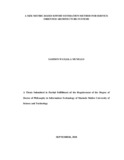| dc.contributor.author | SAMSON WANJALA MUNIALO, SAMSON WANJALA | |
| dc.date.accessioned | 2020-10-27T10:17:34Z | |
| dc.date.available | 2020-10-27T10:17:34Z | |
| dc.date.issued | 2020-09-25 | |
| dc.identifier.uri | http://r-library.mmust.ac.ke/123456789/1393 | |
| dc.description.abstract | Service Oriented Architecture (SOA) is one of the recent software development paradigms that enablealignment of business processes into integrated services within and outside organizationsregardless of the heterogeneity of technologies used. Determining the scope, effort and cost of SOA systems is important to facilitate theplanning and eventuallysuccessful implementation of software projects. A number of methodshave been proposedto estimate effort of building SOA projects.Despite the fact that these methods are promising, the problem of measuring SOA size and estimating SOA effort still remains largely unresolved mainly because there is limited attemptin using Unified Modeling Language (UML)size metrics todefine size-based attributes for estimatingSOA development effort. To address this problem, a set of size metrics were definedand effort estimation method that is based on the size metrics was developed.To automate the computation of the metric and the method, a static analysis tool that usesdeep learning techniques to detect UML arrows and recognize text was constructed. The automated tooldeep learning techniqueswere eachsubjected to validity checks based on datasetsof 100operation names and 100 arrow head images.Briand’s theoretical validationwas usedto test the validity of the designed size metricsand they were found to be mathematically sound. Experimental research design wasemployedto sampled SOA systems to test variables used in the study and the accuracy of the proposed effort estimation method and implementation automated tool. A survey involving experts from the industry was carried out to replicate and validatethe experimentdone by studentsand to determinethe appropriateness of the proposed size metrics, SOA development effort factors and the implementation automated tool. The experiment was based on a sample of 15students’ SOA projectsdeveloped by Meru University of Science and Technology studentswhilethe survey involved 20 programmers from the industry. Descriptivestatistics such as Mean magnitude of relative error (MMRE)and Magnitude of Error (MRE) were used to test SOA effort estimation accuracywhile linear regression analysistested relationshipamong variables identified in the study. Result from the experiment revealed that the proposed metrics and method are more accurate and there is a correlation between size attributes and SOA sizeand between SOA size and SOA development effort. Response from the survey showed that the proposed metrics and effort factors are valid and they have influence onsize and effort respectively. Findings from this study were meant toprovide a basis for future software engineering researchers to develop more effective and more accurate size metrics and effort estimation methods. | en_US |
| dc.description.sponsorship | MMUST | en_US |
| dc.language.iso | en | en_US |
| dc.publisher | MMUST | en_US |
| dc.subject | Metric-Based, Effort, Estimation, Method, Service, Oriented, Architecture, Software,Systems. | en_US |
| dc.title | A SIZE METRIC-BASED EFFORT ESTIMATION METHOD FOR SERVICE ORIENTED ARCHITECTURE SYSTEMS | en_US |
| dc.type | Thesis | en_US |

